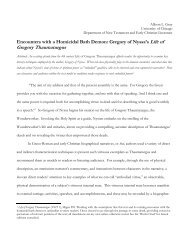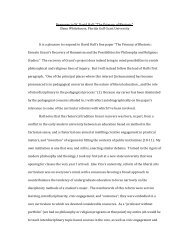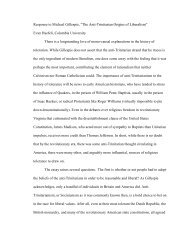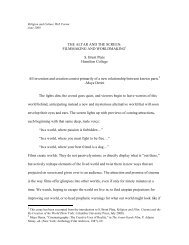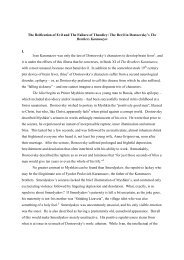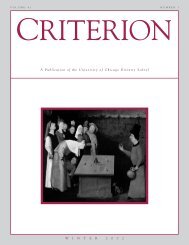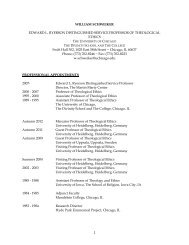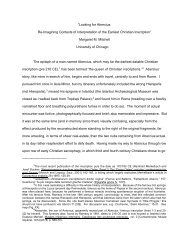Housing the Dead: the tomb as house in Roman Italy - Divinity School
Housing the Dead: the tomb as house in Roman Italy - Divinity School
Housing the Dead: the tomb as house in Roman Italy - Divinity School
Create successful ePaper yourself
Turn your PDF publications into a flip-book with our unique Google optimized e-Paper software.
Hermaes patroni optimi.<br />
20<br />
The presence of Herma himself is felt m<strong>as</strong>sively <strong>in</strong> this epigraphic ensemble. So it is <strong>in</strong> <strong>the</strong> stucco<br />
decoration of <strong>the</strong> <strong>tomb</strong>. The figure of <strong>the</strong> god which occupies <strong>the</strong> central niche opposite <strong>the</strong> entrance<br />
is too damaged for certa<strong>in</strong> identification, but Mielsch feels confident <strong>in</strong> see<strong>in</strong>g <strong>in</strong> him Hermes<br />
(ra<strong>the</strong>r than Guarducci’s Apollo/Harpocrates). Even more strik<strong>in</strong>g, columns are replaced <strong>in</strong> <strong>the</strong><br />
decoration by <strong>the</strong> squared pil<strong>as</strong>ters of Herms; of <strong>the</strong> orig<strong>in</strong>al 23 Herms, 10 Herm heads survive.<br />
S<strong>in</strong>ce <strong>the</strong>se are a non-standard decorative form for a <strong>tomb</strong>, one <strong>in</strong>fers that Herma is play<strong>in</strong>g a<br />
deliberate game with his name.<br />
His self-representation goes far beyond punn<strong>in</strong>g. In <strong>the</strong> bearded figure <strong>in</strong> sacrificial pose on <strong>the</strong><br />
west wall, Mielsch identifies <strong>the</strong> portrait of Valerius Herma (Fig. 28a, Guarducci had seen this<br />
implausibly <strong>as</strong> <strong>the</strong> emperor Marcus), <strong>in</strong> <strong>the</strong> female figures that flank him, his daughter Valeria<br />
Maxima, his wife Flavia Olympi<strong>as</strong> (Fig. 28b). An older male figure is identified <strong>as</strong> his patron, C.<br />
Valerius (Fig. 28c). But <strong>the</strong>se stucco representations (<strong>as</strong>sum<strong>in</strong>g that <strong>the</strong>y do <strong>in</strong>deed consist <strong>in</strong> <strong>the</strong><br />
family group) are backed up by two well-carved marble portraits, of a bearded man and an idealised<br />
woman wear<strong>in</strong>g <strong>the</strong> turban-like hairnet that is typical of <strong>the</strong> second century. They are identified <strong>as</strong><br />
Valerius Herma and Flavia Olympi<strong>as</strong> (Figs 29, 30).<br />
Herma might be thought to have done well <strong>in</strong> terms of self-reproduction. But he is not f<strong>in</strong>ished. His<br />
wife seems to be subject of a fur<strong>the</strong>r portrait, this time <strong>in</strong> stucco, look<strong>in</strong>g older and more tightlipped,<br />
but wear<strong>in</strong>g <strong>the</strong> same turban-like hairnet (Fig 29). It is strange that <strong>the</strong>se remarkable<br />
portraits have not attracted more attention from those concerned with ‘realism’ and ‘idealism’ <strong>in</strong><br />
<strong>Roman</strong> portraiture. The stucco portrait series cont<strong>in</strong>ues. A young woman with wavy hair, and a<br />
young boy with short-cut hair with a quiff at <strong>the</strong> back, are taken to be portraits of <strong>the</strong> prematurely<br />
dead Valeria Maxima and Valerius Olympianus. In <strong>the</strong> latter c<strong>as</strong>e, <strong>the</strong> portrait is gilded, <strong>in</strong>dicat<strong>in</strong>g<br />
an especial importance.<br />
Even so, <strong>the</strong> portrait gallery is not complete. Three startl<strong>in</strong>g death m<strong>as</strong>ks complete <strong>the</strong> collection.<br />
One (surviv<strong>in</strong>g <strong>as</strong> a mould) shows a bearded figure so close to <strong>the</strong> bearded portrait <strong>as</strong> to make <strong>the</strong><br />
choice of Valerius Herma seem <strong>in</strong>escapable (Fig. 30). The f<strong>in</strong>al two, even more powerful, show a<br />
young boy with long eyel<strong>as</strong>hes, hard not to take <strong>as</strong> <strong>the</strong> 4 year old Valerius Olympianus (Fig. 31),<br />
and an even younger child, not identified by Mielsch, though <strong>the</strong> fosterchild Valerius Asiaticus<br />
might be a candidate (Fig. 32).




